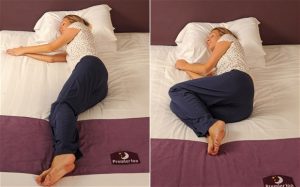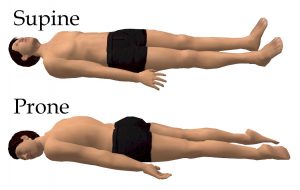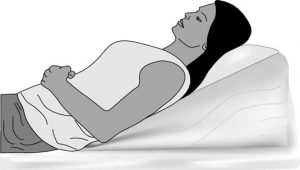How many sleeping positions do you know, rather and more importantly, what’s your dominant sleep position? Not to venture into the wealth of literature you’ve read on the topic at hand, but scientifically speaking, there are only just 3 sleep positions: Sleeping on your stomach, sleeping on you back, or sleeping on your side. Then begs the next question: what good does your reflexive sleep position do you?
Benefits of the different sleep positions
1. Sleeping on your Side:
This touted to be extremely beneficial for anyone with sleep disorders like insomnia, sleep loss and sleep impairment. How so? Scientific research has shown that you’ll easily catch more rest while sleeping on your side; and in this position, you’re much less likely to experience sleep disruption. Apart from this, there can be other methods that can be tried, such as using CBD oil, edibles, or even gummies which can help in overcoming sleep disorders, especially insomnia. People suffering from sleep issues may want to consider such products from the likes of mmj express or similar online stores that can provide cannabis products to help with their ailments. In order to get the most out of cannabis and its related products, you can consume them in various ways. Others prefer the traditional route of smoking up using bongs, water pipes, or dab smoker rigs that might be available in the market, rather than consuming CBD in the form of edibles, gummies, or oil. Personal preference plays a major role here. Coming back to our topic, besides the nocturnal ones with sleep disorders, other groups of people for whom sleeping on the side is highly recommended include people with:
- Hip dislocation or hip pain
- Weak joints and painful joints (inflamed joints)
- Backache and sore shoulders
- Expectant women
(Image courtesy of publicdomainpictures.net)
It is appreciated that sleeping on your side alleviates the pressure and pain imposed on the body’s pressure points and aforementioned key common body complaints. Side-sleeping does not even necessitate the use of a pillow or to use your lower arm as a pillow: this is because your neck will be naturally supported while your lower shoulder is completely hunched (your neck tends to obey gravity by reflexively deviating to grounding).
(Image courtesy of Telegraph.co.uk)
Sleeping on your side can be enacted in several variations of the position, but you’re sure to be most comfortable with your knees curled up towards your chest area while lying on your side. There may be a minor traction formed in the lower back area (about the cervical spine).
2. Sleeping on your Back:
Otherwise called the Supine sleeping position, lying on your back has been known to be counterproductive to sleep by inducing :
- Phases of intermittent sleep apnea
- Sleep deprivation due to sleep loss and sleep disruption – causing an overall lower quality of sleep due to the impact on the normal sleep-cycle
- Agitation of the sleeper leading to restlessness – the supine sleeper may wake up feeling sore or tired especially in the shoulders and back area
Not to rule out sleeping on the back.. A recommended remedy to counter the potential risks of the supine position is by anchoring the knees so that they’re a little elevated; and this could be by placing a rolled towel or soft pillow right beneath the knees. This should naturally align the body, inclining the body’s spine to its natural curvature.
(Image courtesy of en.wikipedia.org)
3. Sleeping on your Stomach:
So far this may very well be the least favored of the aforementioned sleeping positions, lying on your stomach, also known as the Prone sleeping position. Sleeping prone is not recommended by medical professionals, more so sleep experts…They warn that sleeping on the stomach poses the following risks:
Prone sleepers experience constant tossing and turning in bed in a bid to settle in a comfortable sleeping position
- Has been reported to promote restlessness
- Sleeping on your tummy may lead to sore upper shoulders and neck pain
- It leads to strain and tension in the lower back are
- It causes discomfort and compression of your precious internal organ
- Is generally strenuous on your neck and spine
Persons suffering from sleeping disorders are altogether advised against the Prone-position which only further complicates their sleeping disturbances. In such situations, a heavy strain on the neck and the spine can lead to complications in the long run and might require consultations from a reputed neurosurgeon like dr timothy steel!
(Image courtesy of DeviantArt.com)
Nonetheless, the prone sleeper is advised to keep most complications at bay by simply doing without a pillow, or, if absolutely necessary, to get by with a very soft pillow. The cushioning of a pillow is deemed unnecessary in this sleeping position so as to avoid having the sleeper’s neck anchored in awkward uncomfortable angles relative to the spine. On our review of the best memory foam mattress brands, we recommend firm mattresses for stomach sleepers.
(Video courtesy of: Yahoo.com)
Consensus on Most Favorable Sleeping Position
There is to no surprise, a faction of sleep scientists who insist that sleeping on the back (Supine-position) is actually the most recommended way to sleep. Perhaps this has a lot to do with how parents are advised to lay their infant babies in supine positioning, or why inpatients admitted in hospital wards are made to lie down this way by default on their hospital beds. Supporting supine as the healthiest sleeping position is a number of reasons advocating sleeping on your back:
- The supine position posited to promote optimal blood flow to the brain and eliminates the risk of congestion
- Facilitates for easier breathing eliminating the risk of suffocation or obstructed breathing obstruction
(Image courtesy of Wikipedia)
The ultimate supine sleeping position is specified as lying on your back with your head inclined with an elevation of about 10 – 30% for optimal comfort and rest. Case in point, for instance, is lying in a hammock… Even in historical native tradition, the default lying position was inevitably lying on the back in supine position, with that elevation for the natural curvature of the spine — as opposed to lying down on flat level spaces.
Practical Approach to Supine Sleeping Position
It may take a while before you can literally train yourself into a sleeping position that is different from the sleeping posture you naturally and automatically take on when you fall asleep.
(Image courtesy of: Dummies.com)
To enact the proper and supposedly healthiest sleeping position, consider grabbing a couple of pillows, a mattress foam wedge, using block chips to raise the bed at the headboard side, or alternatively using an adjustable bed instead. Ideally, you should have both the head area and leg area elevated, as in an adjustable bed, but only to an optimal comfortable positioning. The wedge foam will go under the leg area to take care of the slight inclination of the legs. Your resultant sleeping position will be almost akin to resting on a reclining chair while leaning your back. It shouldn’t feel unnatural or strained but rather, relaxing, accommodating to the shoulders and back, aligning with the spine, and just right for perfect slumber.







